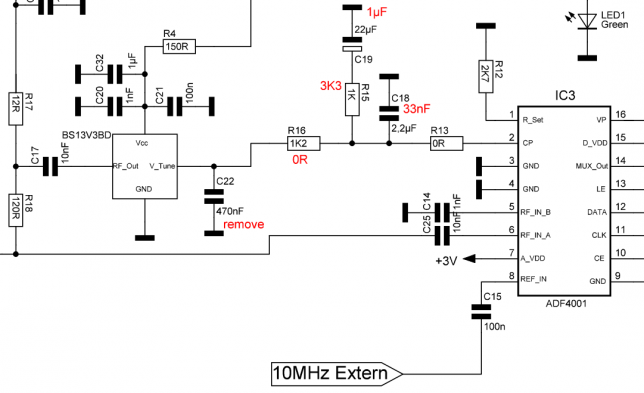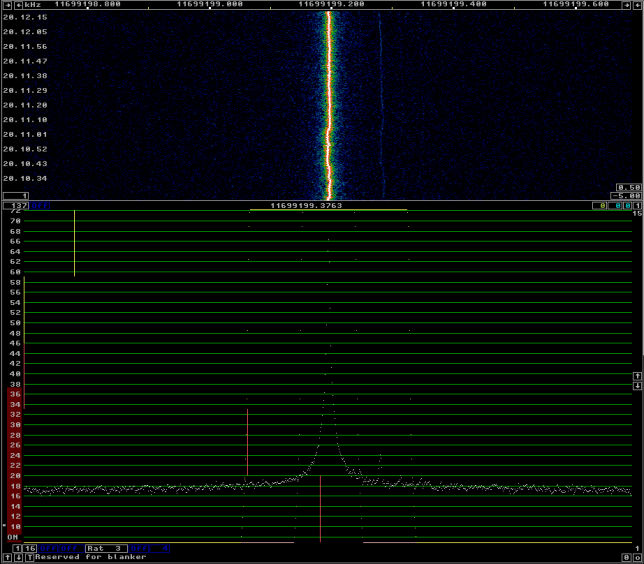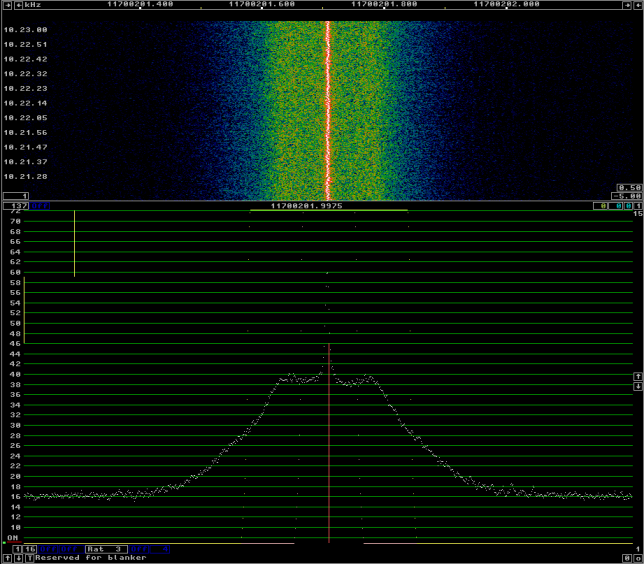In some of the latest posts, I’ve being talking about the phase noise performance of 10GHz receivers, and in particular, of 27MHz references for Ku-band LNBFs (1, 2, 3, 4). Indeed, this started when I checked the performance of my new 10MHz GPSDO and 27MHz PLL by DF9NP and I wasn’t too happy with the phase noise.
After working with Dieter DF9NP in investigating this problem and performing several tests, Dieter found that the problem was likely in the loop bandwidth of the 27MHz PLL. The loop filter bandwidth is 50kHz. He proposed the following component modifications to change the bandwidth to 300Hz.
Update 2018-10-21: Dieter tells me that this problem has been solved in the new units he is selling, so the performance of the new units should be good.

After I performed the modifications, I was quite surprised and happy with the results. As always, I’ve used the beacon of BADR-5 at 11966.2MHz to test the phase noise performance. Linrad’s AFC is in use. The result is below. As you can see, it is as good as the best references that I had tested before.

For comparison, this was the performance before the modification. The difference is huge. Many thanks to Dieter for his effort and to Luis EA5DOM, who also participated in the discussion and gave some good advice.

Hi Daniel. Really interesting stuff here. I find myself wondering about one thing though. If you are using a 10Mhz TCXO to lock a 27Mhz PLL, why not just use a 27Mhz TCXO and cut out the PLL? Is it that the 10Mhz TCXO has better stability than a 27Mhz one? Perhaps I’ve misunderstood and that you were just comparing the phase noise of a 10Mhz TCXO with a GPSDO at 10Mhz? 73
Hi Russ. The 10MHz TCXO was only for tests. The goal is to have GPS-locked 27MHz for the satellite LNBF. The natural way to achieve this is 10MHz GPSDO plus 10MHz to 27MHz PLL, and Dieter DF9NP sells both. When I tested the 10MHz GPSDO + 27MHz PLL I found out that the phase noise was high. Dieter suggested replacing the GPSDO with a TCXO (which should be pretty clean) to see main contributor to phase noise was the GPSDO or the PLL. As you can see on the previous posts, the phase noise was high even when the PLL was running off the TCXO, so the phase noise problem was in the PLL.
Hi Daniel and thanks for the quick reply! I understand now. However, do you not think that a TCXO would do the job for listening to the Es’Hail2 transponder? A GPSDO makes the whole thing rather elaborate and expensive (although clearly the very best solution).
Great website by the way!
Yes. An GPSDO is an probably an overkill just for listening to Es’Hail 2, but it enables me to do other experiments.
Probably the best solution in terms of bang per buck is this: http://www.qrp-labs.com/ocxokit For only $16 you get a 27MHz OCXO (kind of, but it works more or less OK) and a Si5351A frequency synthesizer. The Si5351A can be used as a buffer for the OCXO or it can generate a completely different frequency. This is handy in case you want to downconvert Es’Hail2’s narrowband transponder to 432MHz or if you want to downconvert the wideband transponder to some L-band frequency in the tuning range of a usual DVB-S receiver. I had one of these before getting the GPSDO. It works well.
Thank you, Daniel. Your advice is greatly appreciated. I think I will buy an Si5351A. It does seem very good value!
73
Hi Daniel ,
Could you maybe make a note that this was at the early beginning of the design and permantely solved.
Some People are still concerned.
BTW Problem was that the Loop was 50KHz , not 50Hz as you
mention.
vy 73 Dieter
Hi Dieter,
No problem. I have added an update near the beginning of the post, so I think it will be quite visible.
Regarding the loop bandwidth, I think I took the value of 50Hz from email communication (perhaps a typo) and never cared to checked if it made sense. I have also corrected this.